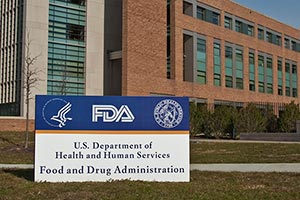Senior Reporter
FDA Previews Final Food Safety Transportation Rule

The U.S. Food and Drug Administration on April 5 previewed its final rule that creates new requirements for the sanitary transportation of human and animal food by truck and rail to ensure that transportation practices do not create safety risks.
“Practices that create such risk include failure to properly refrigerate food requiring temperature control for food safety, the inadequate cleaning of vehicles between loads and the failure to otherwise properly protect food during transportation,” the agency said in its rule scheduled for publication in the April 6 Federal Register.
The rule establishes requirements for sanitary transportation practices applicable to shippers, loaders, carriers by motor vehicle and rail vehicle, and receivers engaged in food transportation.
LINKS FROM FDA: Fact sheet | Q and A
“Due to illness outbreaks involving human food and animal food that became contaminated during transportation, and incidents and reports of insanitary transportation practices, there have been concerns over the past few decades about the need to ensure that food is transported in the United States in a sanitary manner,” the rule said.
“Consumers deserve a safe food supply, and this final rule will help to ensure that all those involved in the farm-to-fork continuum are doing their part to ensure that the food products that arrive in our grocery stores are safe to eat,” Michael Taylor, FDA’s deputy commissioner for foods and veterinary medicine, said in a statement.
The rule specifically addresses requirements related to vehicles and transportation equipment, transportation operations, training, records and waivers.
Businesses would be required to comply with the new regulation one year after publication of the final rule, with smaller businesses having two years to comply with the new requirements.
Jon Samson, executive director of American Trucking Associations’ Agricultural & Food Transporters Conference, said he generally was pleased with the final rule.
“There were some pretty significant changes made on the positive side,” Samson told Transport Topics.
Samson said the final rule will allow a food receiver to make the call whether the food was adulterated or not, if for example, a proper food temperature stipulated in a contract was not precisely maintained during transport.
The proposed rule would have automatically required that the food be declared as adulterated, Samson said.
“Also, they’re backing off on any sort of prescriptive requirements for temperature monitoring or continuous monitoring,” Samson said. “That was another big one because sometimes it isn’t necessary, especially if you’re doing shorthaul movements to constantly be monitoring the temperature.”
Some of the changes the agency made in its 283-page final rule to its 2014 proposed rule include:
• Simplified definitions for parties covered by the rule to make them all activity-based and added a definition for “loader” as a new party covered by the rule.
• Amended the definition of “transportation operations” such that additional transportation activities are not covered by the rule, including transport of food completely enclosed by a container, except food that requires temperature control for safety, food contact substances, and human food byproducts transported for use as animal food without further processing.
• Changed the provisions of the rule to focus on food safety concerns and not additionally adulteration as a result of spoilage or quality defects.
• Removed prescriptive requirements for temperature-monitoring devices and continuous monitoring of temperature during transport and replaced these provisions with a more flexible approach, which allows the shipper and carrier to agree to a temperature-monitoring mechanism for shipments of food that require temperature control for safety.
• Removed the provision requiring the carrier to demonstrate temperature control to the receiver for every shipment requiring temperature control.
• Revised the rule to require that if a person subject to the rule becomes aware of an indication of a possible material failure of temperature control or other conditions that may render the food unsafe during transportation.
• Revised the requirements of the final rule to make it clear that its requirements account for the fact that the intended use of the vehicle or equipment with respect to the type of food that is being transported is relevant in establishing the applicable sanitary transportation requirements.
• Revised the rule to primarily place the responsibility for determinations about appropriate transportation operations on the shipper.
FDA said it received 240 comments on the proposed rule from individuals, industry and trade associations, consumer and advocacy groups, academia, law firms, professional organizations, federal and state, tribal and foreign government agencies and other organizations.
See Full Rule Below.

